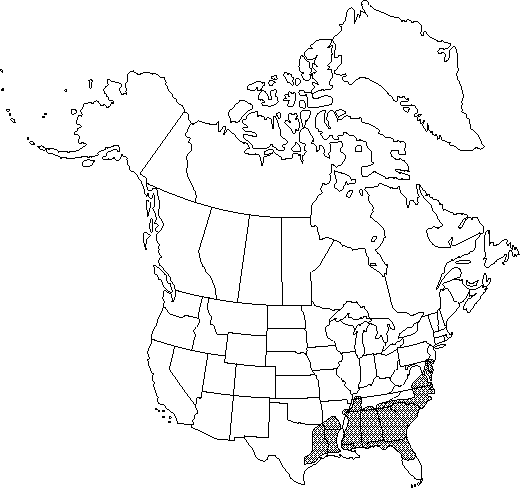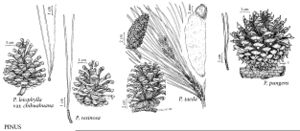Difference between revisions of "Pinus taeda"
Sp. Pl. 2: 1000. 1753.
FNA>Volume Importer |
FNA>Volume Importer |
(No difference)
| |
Revision as of 18:56, 24 September 2019
Trees to 46m; trunk to 1.6m diam., usually straight, without adventitious shoots; crown broadly conic to rounded. Bark red-brown, forming square or irregularly rectangular, scaly plates, resin pockets absent. Branches spreading-ascending; twigs moderately slender (to ca. 1cm thick), orangish to yellow-brown, aging darker brown, rough. Buds lance-cylindric, pale red-brown, 1–1.2(–2)cm, mostly less than 1cm broad, slightly resinous; scale margins white-fringed, apex acuminate. Leaves 2–3 per fascicle, ascending to spreading, persisting 3 years, (10–)12–18(–23)cm × 1–2mm, straight, slightly twisted, pliant, deep yellow-green, all surfaces with narrow stomatal lines, margins finely serrulate, apex acute to abruptly conic-subulate; sheath 1–2.5cm, base persistent. Pollen cones cylindric, 20–40mm, yellow to yellow-brown. Seed cones maturing in 2 years, shedding seeds soon thereafter, not persistent, solitary or in small clusters, nearly terminal, symmetric, lanceoloid before opening, narrowly ovoid when open, 6–12cm, mostly dull yellow-brown, sessile to nearly sessile, scales without dark border on adaxial surface distally; apophyses dull, slightly thickened, variously raised (more so toward cone base), rhombic, strongly transversely keeled; umbo central, recurved, stoutly pyramidal, tapering to stout-based, sharp prickle. Seeds obdeltoid; body 5–6mm, red-brown; wing to 20mm. 2n =24.
Habitat: Mesic lowlands and swamp borders to dry uplands
Elevation: 0–700m
Distribution

Ala., Ark., Del., Fla., Ga., Ky., La., Md., Miss., N.J., N.C., Okla., S.C., Tenn., Tex., Va.
Discussion
Originally most races of Pinus taeda were in the lowlands. Following disturbance of the natural vegetation after settlement by Europeans, the species spread to fine-textured, fallow, upland soils, where it now occurs intermixed with P. echinata and P. virginiana. In the Southeast P. taeda is commonly used in plantation forestry, along with P. elliottii and P. echinata. Pinus taeda frequently forms hybrids with P. echinata and P. palustris (P. × sondereggeri H.H. Chapman). Commercially, it is a valuable pulpwood and timber species.
Selected References
None.
